What is Inventory Management?
Inventory management is the process of monitoring and managing stock levels to keep track of product movements across all points in the supply chain.
From raw materials (for those businesses that deal with them) to finished goods (products), inventory management solutions aim to achieve end-to-end visibility of a company’s entire inventory. As well as documenting every single product that enters and leaves the warehouse, good inventory management systems allow you to observe and manage internal and external order management processes.
This doesn’t only include the status of sales orders you place with your suppliers and the pending orders of your customers. It also includes enhanced visibility and management of the shipment and delivery processes too, right up until your product reaches your customer’s front door.
The best inventory management systems also automate important-but-tedious manual processes to reduce human error and streamline daily order fulfillment and warehouse operations. Naturally, this speeds up your time-to-delivery and enables your business to provide a better customer experience.

Importance of Inventory Management
Inventory management is an incredibly valuable asset for every organization’s short and long-term success. First and foremost, it helps you to document and track all of your inventory information including stock, accounts, and sales, which gives you a good indication of your company’s health and growth.
However, inventory management solutions are also critically influential to your product logistics decision-making process. With the help of inventory management systems, you can accurately identify growing trends and respond quickly to customer demand, adjust product prices to maximize ROI and profitability, and make data-driven stock intake decisions depending on current sales.
An inventory management system’s ability to prevent stockouts is perhaps one of its most valuable operations. Adobe reports that in October 2021 alone, online shoppers saw over 2 billion out-of-stock messages, which is worrying when you consider the devastating impact that stockouts can have on the quality of your customer experience and your business’ overall revenue.
Stockouts—particularly if your business is a repeat offender—can seriously harm your brand’s reputation. They can lose you sales, decrease brand loyalty, and lead your customers to run straight to your competitors.
In 2020, IHL Group research discovered that inventory distortion cost businesses $1.8 trillion worldwide, with stockouts accounting for a staggering 80% of the total cost.
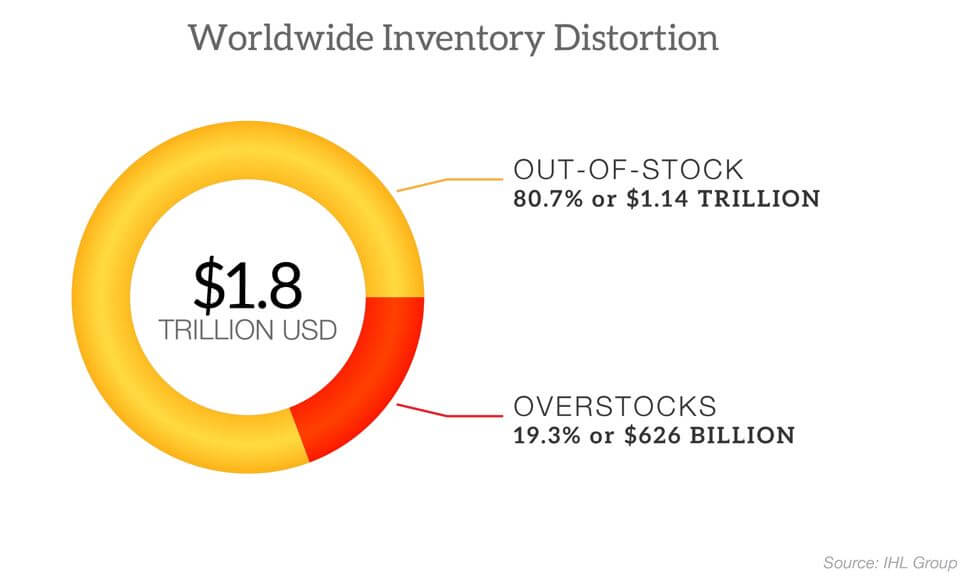
Thanks to continuous technological advances, inventory management has become more streamlined and efficient than ever before, in an attempt to prevent the destructive losses of understocking and overstocking.
Advanced inventory management softwares automate some of the repetitive manual processes that eat away at employee productivity, including stock reordering, customer order processing, inventory fulfillment, and data tracking.
When combined with CRM and EDI integrations, the top inventory management systems empower you to spend less time on the tedious tasks, and more time concentrating on what really matters—delivering an exceptional experience to your customers every single time.
See how Brightpearl can improve your inventory management efficiency
Types of Inventory Management & Related Systems or Tools
The type of inventory management method that you use will depend on your individual business needs and goals.
The size of your inventory, your allocated budget, your integration requirements, and whether you manage one or multiple warehouses are all factors that will come into play as you journey to discover the right inventory management system for you.
Let’s quickly touch on some of the most notable types of inventory management method that you might consider, as well as some related terms and tools to consider.
Periodic Method
The periodic inventory method is a type of inventory valuation practice where stock is physically counted at the end of each specified accounting period rather than continuously. This information is used to update the ending inventory balance in the general ledger, which is then applied to the beginning inventory.
Because no continuous records are kept, and businesses must guess the cost of goods sold during interims, a periodic system is most suited to small businesses with stock that is easy to account for. Larger businesses are likely to encounter serious inaccuracies when it comes to stock estimation, which significantly increases the risk of overstocking, understocking, and failing to identify trends.
Perpetual Method
The Perpetual inventory management method involves continuously recording stock intake and product sales in real-time for an accurate and detailed view of inventory information. Because inventory records are automatically updated immediately after every transaction of goods received or sold, businesses are able to prevent stockouts by keeping inventory levels optimal.
On-Premises Inventory Management Software
While startups and established businesses alike have migrated to the cloud in response to the skyrocketing popularity of e-commerce, on-premises inventory management software is still used by some. On-premises systems host their own servers and all inventory management and maintenance is done internally on in-office desktops.According to research by Statistia, 48% of retail supply chain executives were looking to invest in improving their inventory management tools and strategies in 2021. This potentially indicates that the number of businesses migrating away from on-premises inventory software is set to continue to rise.
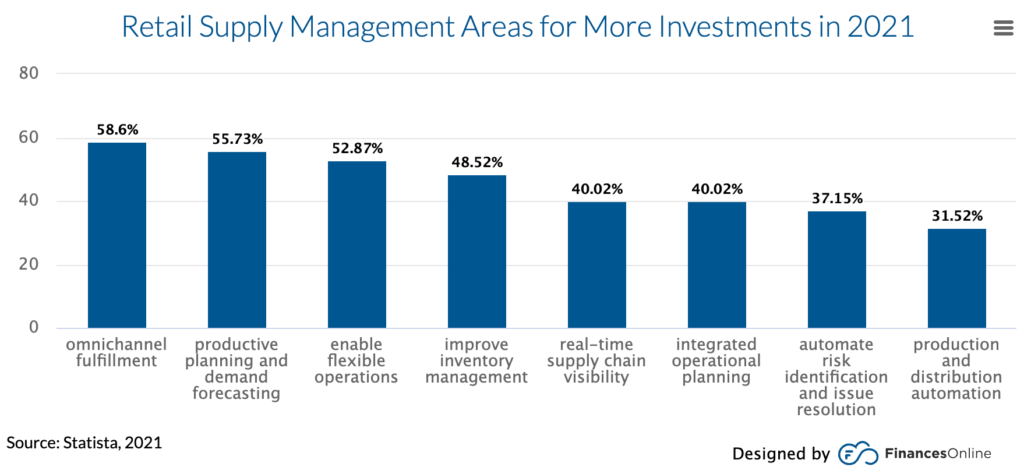
Cloud-Hosted Software
Cloud-hosted inventory software eradicates the high-cost, stress-inducing monotony, and potential for human error that often befalls outdated manual or on-premises inventory management approaches.
Your entire product catalog is stored, accessed, and managed in the cloud, meaning that you don’t have to purchase or perform maintenance and upgrades, and can access your multichannel inventories from any location and mobile device.
SaaS Systems
A SaaS inventory management system is a type of cloud-hosted software that differs from an on-premises inventory solution in that the system is hosted on an offsite provider’s server rather than the business’ own server. As long as the business has a reliable internet connection and the right applications, they can access data just as easily as they could on an on-premises system. They also don’t have to handle maintenance and upgrades, which is an added bonus.
Barcode Systems
Barcode inventory systems combine hardware and software to simplify and streamline the organization, tracking, and management of stock. Products can be assigned a unique barcode and serial number which, when scanned with a barcode scanner, sends the relevant information to a centralized computer system (this might be data like the supplier name, weight, or how many of the items are left in stock).
Barcodes can also be assigned to locations to enable businesses to track inventory movements from location to location. Barcode systems are immensely popular thanks to their reliability, which is why many software providers (like Brightpearl) boast barcode generation functionalities that can be used with POS barcode scanners, added to product labels, or used in warehousing.

RFID Tagging Software
Radio-frequency identification (RFID) is a software tagging technology similar to barcode scanning in that it assigns RFID tags to products and then stores their data on a centralized computer system for tracking and management purposes.
RFID tagging software is considered to be a more advanced solution than barcode scanning. This is because RFID tag data can be read outside the line-of-sight, can hold considerably more product data, and isn’t vulnerable to label damage. However, it is considerably more expensive and many deem it a less efficient solution in comparison.
What is Cloud Inventory Management Software?
Cloud inventory management software significantly increases your inventory control capabilities. It allows you to access, monitor, and manage your inventory data on any internet-connected device, from anywhere in the world.
Software as a Service (SaaS) providers host inventory control systems in remote data centers, removing the considerable costs that come with hardware and overhead management, while providing businesses with extra security and increased redundancy. They also handle installation, maintenance, upgrades, and patches, meaning that businesses don’t have to waste time attending to these behind-the-scenes tasks.
While some businesses prefer the full ownership rights of legacy systems, cloud-based solutions have catapulted into mainstream popularity as the business climate demands agility and adaptability. The innate flexibility of cloud-based solutions is, in fact, its most alluring and powerful advantage.
Because the service is hosted in the cloud, you no longer have to be stuck in the warehouse, store, or office to observe and manage inventory records.
Employees are granted unrestricted access to their inventory at any time of day, and from any location. You and your employees can quickly sign into your provider’s app on your mobile phone or desktop and perform inventory management duties with the same (if not more) efficiency and visibility as you could if you were using a traditional inventory management system.
Cloud Based Vs. Traditional Inventory Management
The fact that cloud-based inventory management systems are hosted at an offsite location that can be accessed through an internet connection is the main thing that distinguishes them from traditional inventory management.
Traditional inventory management systems are stored and managed onsite, meaning that they can only be accessed from a single location during set working hours. This not only goes for employees, but emergency maintenance services, too—unless businesses have a round-the-clock technician on call, issues can only be attended to within a given timeframe.
If your hardware malfunctions or there’s a power outage, you’re looking at increased downtime with a traditional inventory system.
With a cloud platform, there’s a much greater degree of accessibility and flexibility. Not only are they less vulnerable to malfunctions and outages, but your service providers handle maintenance, upgrades, and issues for you. Many also offer 24/7 service support across different channels to ensure that you experience as little downtime as possible.
Along with increased reliability, data integrity, and scalability, cloud-based inventory management boasts numerous benefits over traditional methods. With Arcserve research predicting that the cloud will store 50% of the world’s data by 2025, it seems highly likely that more and more businesses will migrate to cloud inventory systems to reap these advantages.
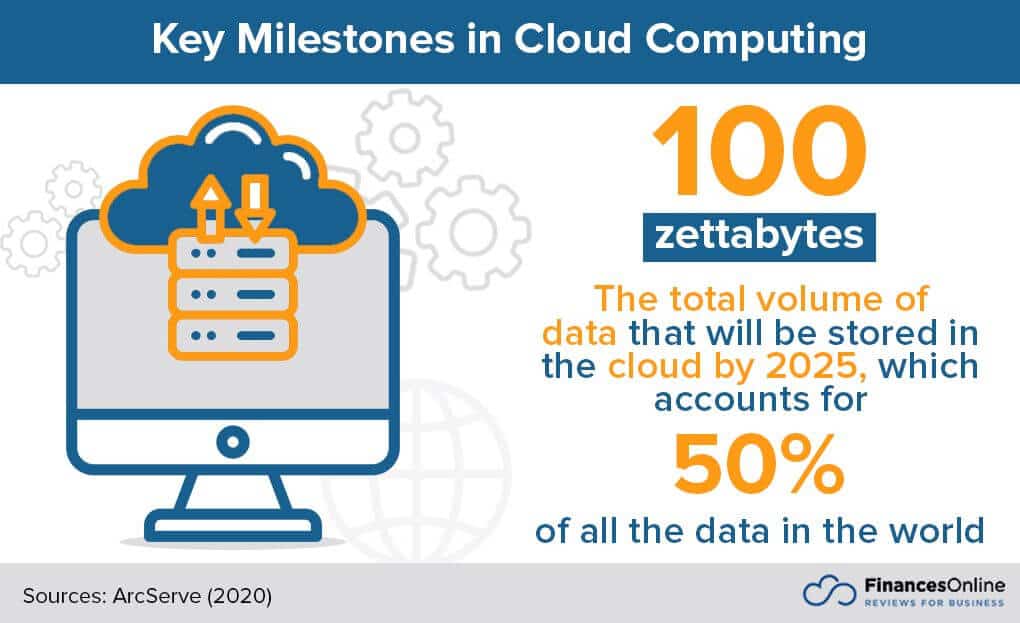
Benefits of Cloud Inventory
So, we’ve established that accessibility is a standout benefit of cloud-based inventory systems, but what other benefits do they offer for businesses?
Convenient
Convenience isn’t just the key to customer satisfaction. Cultivating convenience in the workplace is hugely beneficial for streamlining daily workflows and nurturing employee happiness and satisfaction.
Cloud inventory solutions give you a real-time look at your inventory with as much accuracy as if you were physically in the warehouse. Whether you’re on the shop floor, traveling to a meeting, or working from home, you can view and track stock amounts, pending orders, automated processes, and more, right from your mobile phone.
Data Integrity
Cloud systems automate your inventory processes and update their status in real-time, significantly minimizing the risk of human error and maximizing data accuracy.
At the click of a button you can view the most up-to-date inventory counts and order statuses. This enables you to make pivotal, data-driven business decisions with confidence, and ensures that the information you deliver to customers is as accurate as possible.
Scalable
Unlike other inventory systems that require you to purchase additional storage space or perform IT and software upgrades if your business grows, cloud-based inventory systems are inherently scalable. With an infrastructure that natively supports exponential growth, you don’t have to worry about the costs or physical practicalities of growing your business. You can just do it!
Low Maintenance and Cost
Even if you’re not necessarily looking to scale, cloud inventory solutions are renowned for their cost-effectiveness. Unless you opt for an advanced ERP system (which we wouldn’t recommend for growing e-commerce businesses due to ERPs’ inflexibility and poor implementation success), then you can enjoy fairly low initial and recurring fees.
There’s no need to invest in an onsite server, maintenance expenses, or overhead costs. With SaaS providers like Brightpearl, pricing is predominantly based on order volume, meaning that when your order volume goes up, the cost per order comes down. You’ll pay a monthly subscription fee depending on your rate of growth and get maintenance, support, and customization included.
A much more affordable solution than both on-premises systems and advanced ERP systems.
Customer Satisfaction
With a cloud inventory management system, you have the power to deliver an exceptional customer experience. If a customer calls to check whether something is in stock or inquires about the status of their order, you can quickly find and provide the most up-to-date information.
Cloud inventory management also speeds up your stock and delivery processes to make them more efficient. You can replenish stock faster (with higher demand accuracy), process orders quicker, and deliver within shorter timeframes, empowering you to consistently meet your customer’s needs.
As a result, you increase brand loyalty, boost customer satisfaction, and retain more high-value customers.
Industries That Need Cloud Inventory
Of course, any industry that handles a large amount of stock can benefit from a cloud inventory solution to ease order management and workflows, and improve customer experiences. However, for some industries, a cloud inventory solution could be considered a fundamental requirement regardless of their size.
Put simply, any consumer-goods or e-commerce business should prioritize adopting a cloud-based inventory system if they haven’t done so already. This is particularly true if you operate multiple offices, stores, or warehouses. However, specific industries that need a cloud inventory software solution include food distribution, clothing, toys, electronics, cosmetics, and homeware.
According to a recent Deloitte survey, consumers shopping in all of the above niches are increasingly worried about items being out-of-stock during holiday periods, to the point where it has become a wide-spread expectation.
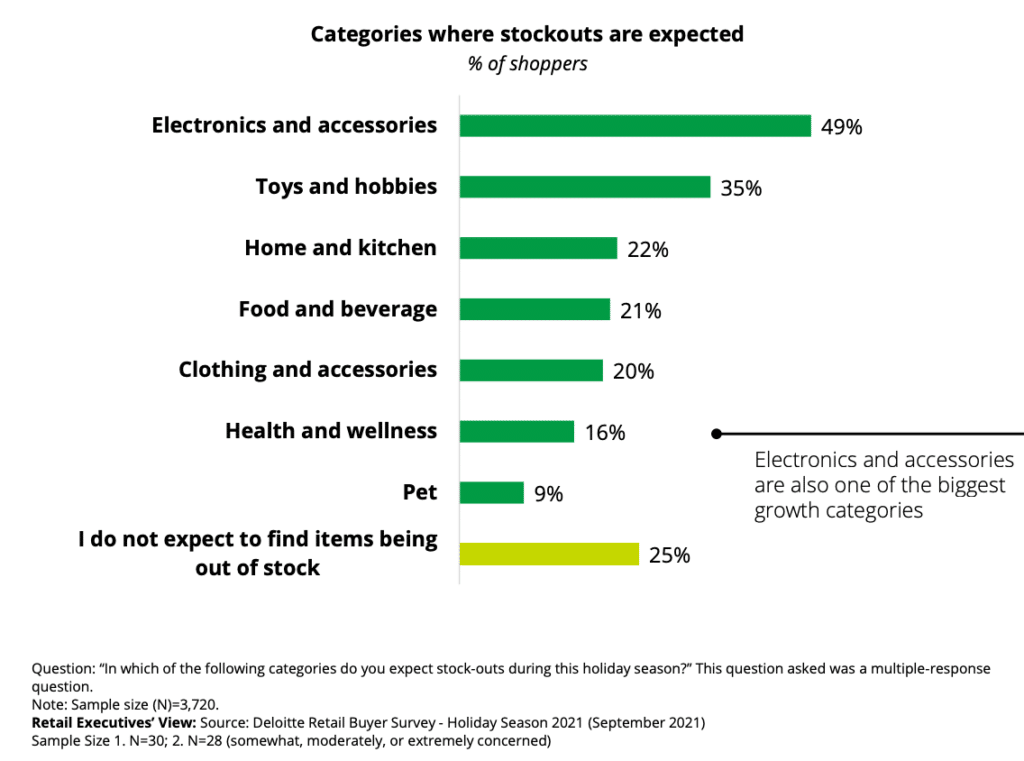
Source: deloitte.com
With supply chain constraints aggravating retail industries, a cloud inventory solution takes some of the pressure off.
Brightpearl for Inventory Management
When you’re choosing an inventory management solution, you ideally want to invest in a system that natively caters to the needs of your industry. This is where Brightpearl shines, as it’s a Retail Operating System designed specifically for e-commerce, multichannel retail, and wholesale businesses.
Brightpearl’s powerful cloud-based solution comes with a bunch of dedicated inventory management features like multi-location, CRM, and inventory control functionalities. This means that businesses gain so much more than with a one-size-fits-all inventory management or ERP system.
Inventory Control and Demand Forecasting
Along with automated inventory updates and multichannel syncing, businesses can benefit from the integrated Inventory Planner to improve the accuracy of their data-driven forecasting. Having taken into account your sales history & promotions, Inventory Planner allows you to ensure you always have the right inventory at hand. Brightpearl even provides you with a replenishment report of the suggested products to restock, you can then create purchase orders straight from the report with just a couple of clicks.
Basically, no more relying on gut feelings or estimations! With Brightpearl, you can use your own accumulated data to assist you in the identification of industry trends and demands, responding with increased accuracy to what your new and loyal customers desire.
Top-Notch Integrations
No one system can provide top-class features which are all built themselves, that’s why the best inventory management softwares allow you to use integrations to make the most of the best channels, marketplaces, POS, shipping & other options. From Amazon and Shopify to PayPal and QuickBooks, Brightpearl’s in-house experts will implement and configure your integrations to ensure they’re entirely free of any glitches or delays from the get-go. This is thanks to the system’s high-performance Plug & Play integrations and fast, open API.
With this selection of integrations and huge partner network you’ll have the flexibility to scale in whichever direction you need to best grow your business.
| Brightpearl | Tradegecko | Odoro | Fishbowl | Cin7 | Veeqo | |
| Amazon | 👍 | 👍 | 👎 | 👍 | 👎 | 👍 |
| Shopify | 👍 | 👍 | 👍 | 👍 | 👍 | 👍 |
| MailChimp | 👍 | 👍 | 👎 | 👎 | 👍 | 👎 |
| PayPal | 👍 | 👎 | 👎 | 👎 | 👍 | 👎 |
| Stripe | 👍 | 👎 | 👍 | 👎 | 👍 | 👎 |
| QuickBooks | 👍 | 👍 | 👍 | 👍 | 👍 | 👍 |
| USPS | 👍 | 👎 | 👎 | 👍 | 👎 | 👎 |
Automation Engine
One of the standout features of Brightpearl’s Retail Operating System is its rules-based Automation Engine. It allows you to easily customize rules to automate and centralize those tedious, time-consuming tasks including dropshipping, order fulfillment, partial transfers, invoicing, order splitting, multi-location inventory allocation, and more.
A useful example of how you can use Brightpearl for automation is through its reorder points system. You can set stock thresholds for each individual product and be automatically notified whenever a product’s count hits that threshold.
From there, you can maintain replenishment by automating redelivery; sending automatic emails to your suppliers and manufacturers to place an order.
Why Should you Work With Brightpearl?
So, why should you choose Brightpearl? Well, along with its e-commerce and retail-dedicated features, there are many other reasons for choosing Brightpearl beyond the face-value benefits of its streamlined inventory control, process optimization, demand planning, and automation functionalities.
Expert implementation
When you’re looking at switching to a new Retail Operating System, you need to be confident that the system is the right fit for your business and there won’t be any issues later on with features missing or pricing increasing due to extra required customization.
Brightpearl uses a different model which involves scoping out your project before you sign any paperwork. Through this method you can be confident that everything is covered before putting pen to paper. You’ll be provided with a fixed cost quote so you know exactly what to expect.As you can see in the graph below, 20% of businesses found that implementing ERP systems resulted in budget overruns due to increased customization needs.
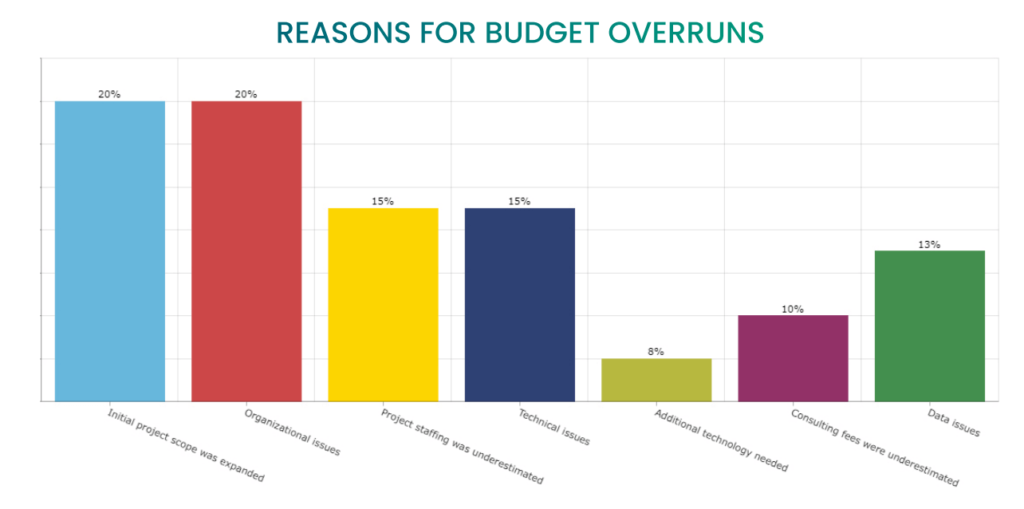
Source: Panorama-Consulting-Group-The-2020-ERP-Report.pdf
Ease-of-Use
Another reason for choosing Brightpearl is its exceptional ease-of-use and flexibility. Not only can you access all of your tools and apps from one centralized platform right from your desktop or mobile device, but you can do it on an intuitive dashboard that guarantees effortless use for all of your employees, regardless of their IT ability.
24/7 Service Support
With that being said, if you do have any problems, Brightpearl’s customer service is second to none. Friendly, in-house tech experts are right there with you from the deployment process onwards, offering onboarding training, ongoing business consultations, and unlimited 24/7 phone and email support.
Have a quick question? Brightpearl customers can even access a comprehensive online library of support documentation for fast and efficient self-service.
Conclusion
E-commerce initially served as a strategy used by businesses to simply complement brick-and-mortar stores. However, with the advancement of technologies like automation and the IoT, along with the ever-increasing popularity of social media and mobile devices, e-commerce is quickly beginning to dominate over traditional commerce.
As it stands, approximately 2.14 billion of the world’s population shop online according to Statista. That’s one out of every four people you see. And along with the growing number of online shoppers comes higher customer expectations, most notably a growing demand for a more personalized, streamlined customer experience.
Customers want up-to-date inventory information with alerts if an item is running out of stock. They want to know the exact movements of their purchase orders, from the processing stage through to dispatch.
And of course, they want timely, trackable delivery with same or next-day delivery options.
According to Dropoff research, almost a third of consumers say they feel frustrated when a company doesn’t offer same-day delivery.
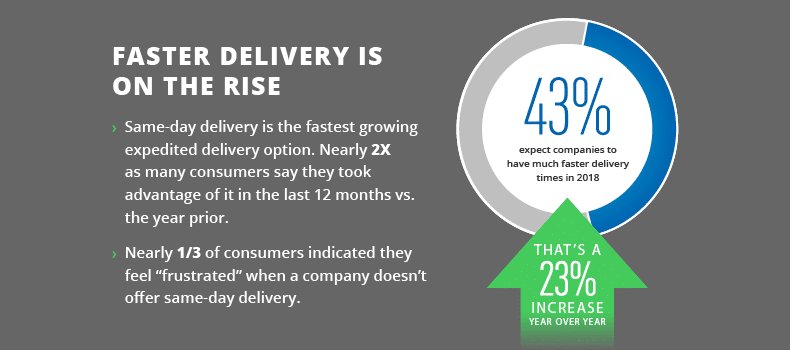
Source: dropoff.com
A cloud-based inventory management software solution makes meeting these demands possible. Regardless of how simple or complex your fulfillment or warehousing needs are, a system that provides end-to-end visibility of your inventory along with integrated demand forecasting is crucial for meeting customer expectations while decreasing the substantial business losses that occur due to understocking or overstocking.
In many instances, demand planning increases your overall sales because you’re able to more accurately identify and respond to trends.
However, as we move away from Excel spreadsheets and manual stocktaking, it has become clear that an inventory management system is essential for more than just your end-to-end stock visibility needs.
The automation capabilities of inventory management software play a fundamental role in our warehouse organizational processes, post-purchase operations, and metric tracking and analysis abilities which, in turn, equip us with the resources and data we need to provide a personalized customer experience.
By implementing automated order processing, removing the inefficiencies in our workflows, and integrating inventory management systems with other essential sales channels and tools, we can optimize the entire order management process to ensure that customers receive the products they want, as quickly as they want them.
Ensuring that the inventory software you chose meets your unique business needs is vital. With Brightpearl’s Retail Operating System (built specifically for multichannel ecommerce retail and wholesale businesses), you gain industry-specific features along with enhanced integrations and ample potential for customization.
And in a business climate that is steadily embracing remote and hybrid working, the cloud-based system grants your team the flexibility to access your entire system from their mobile device anywhere, anytime.
